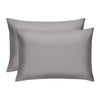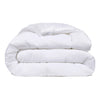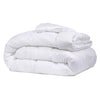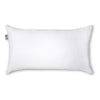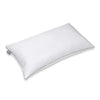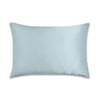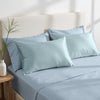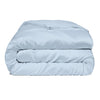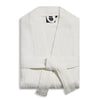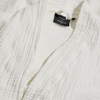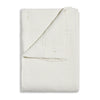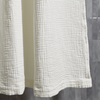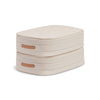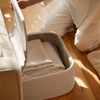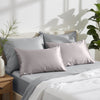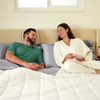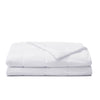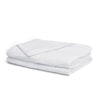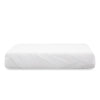The Daily Miracle
Percale vs Cotton: What's the Difference?
Published
March 28, 2023
Author
Suze Dowling

If it is time for you to purchase a new set of sheets, you’ve likely done some digging to find your best option. As you do your research, you’ve probably realized that the world of bedsheets is much larger than you initially thought.
There are hundreds of sheets with different thread counts, materials, and even weave patterns. Two words that have probably popped up in your Google search quite often are “percale” and “cotton.”
What is cotton percale vs cotton? Are they the same thing? Is one better than the other? What are the best sheets you can buy for your bed? In this article, we’ll tackle the answers to all your cotton vs percale bedsheet questions.
There is a difference between cotton vs percale sheets, but it may not be what you think. It is not a question of material; it’s actually a question of function. Cotton is the material used to make many different types of sheets.
Percale, on the other hand, is the type of weave used to make certain bedsheets. Most percale sheets are made from cotton.
Now that we have the basic percale vs cotton sheet question answered, let’s learn a little bit more about cotton vs percale.
What Is Cotton?
Cotton is both a plant and a fiber. It is grown on a cotton plant, and the fibers are used to create the material we think of when we hear the word cotton. It is made mostly of cellulose and is grown in tropical climates. The cotton plant can grow up to 20 feet high.
Three different types of cotton fibers are used to make things like sheets, blankets, and clothing. They are classified by staple length, which is the average length of the fibers in a bale of cotton.
Long staple cotton is the most expensive because it is the rarest length. Medium staple cotton is average cost and used in many common materials. Short staple cotton is the least expensive, used in lower-quality items or blended with other fibers.
What Are the Benefits of Cotton Sheets?
Cotton sheets are among the most commonly found and are the most popular type of bedding. This is due to their many benefits.
The top benefits of cotton sheets are:
-
Durability. Cotton sheets can last an incredibly long time, making them a good investment for bedsheets.
-
Breathability. Cotton lets the heat escape from the sheets, so if you tend to sleep hot, cotton sheets are a good choice to cut down on night sweats.
- Hypoallergenic.Cotton sheets are typically made in such a way that all the gross things your sheets can pick up (dust mites, mold, and other allergens) don’t get caught in the fabric.
What Are Alternatives to Cotton?
Cotton isn’t your only option when it comes to sheet shopping. There are other materials often used to make bed sheets.
Bamboo
Bamboo sheets are soft and are made with rayon. They are popular because of their breathability and eco-friendliness. They are the most similar to cotton sheets without actually being made from cotton. While they have many pros, they can also wrinkle and shrink fairly easily.
Linen
Linen is made from the stem of the flax plant. It isn’t as soft as cotton, but it can still be a good option for sheets. The benefits of linen include durability and moisture-wicking. Linen is great for summertime as it feels nice and cool against the body.
Polyester
Polyester is a man-made fabric created with the same type of material used to make plastic bottles. It isn’t typically a first choice for high-quality sheets. It has a few benefits, including affordability, and is easy to care for. On the other hand, it doesn’t absorb moisture which can cause problems for those with allergies or who sleep hot.
Microfiber
Microfiber is not a natural material. It is man-made, but it is extremely soft. It is made from tightly woven polyester. The benefits include comfort, affordability, and allergy-friendliness. However, it is not very breathable and tends to be on the thin side.
Silk
Silk is made from the fiber in silkworms’ cocoons. It is extremely soft and is often used to make luxury sheets. While they are comfortable, the price point on true silk sheets is quite high, and some complain that they are too slippery.
What Is Percale?
Now that you know all about cotton, it’s time to do a deep dive into percale. Percale is a type of weave used to make sheets. They are typically made from cotton, but percale sheets can also be made with bamboo, polyester, or other synthetic fabrics. The highest quality percale sheets will likely be made with cotton.
Percale sheets are made with a criss-cross pattern that is very simple. It is a one-over, one-under pattern. They are woven together extremely tight using long-staple cotton. The percale weave turns out nice and crisp.
What Are the Benefits of Percale?
There are many pros to using percale sheets. They last a long time and can feel better over time. They go through a bit of a wearing-in period before they are nice and soft.
Percale sheets are extremely breathable, making them perfect for hot sleepers. They’re easy to put on your bed and can be machine washed and put in the dryer. The price range is fairly wide; you can get a set of percale cotton sheets from anywhere between $50 and $500, so you can find one well within your budget. A great set of sheets is worth the investment!
There are only a few small cons to using percale sheets. First, they are prone to wrinkles. If this doesn’t bother you, that’s great! You can leave them a little wrinkled for a well-loved and lived-in look.
You can also take steps to prevent wrinkles by removing them from the dryer while they’re still a little damp or ironing them to remove wrinkles. Percale sheets are also not extremely warm, which can be considered a con for some, while it’s the ultimate pro for others!
Are There Alternatives to Percale?
The biggest alternative to percale is called sateen. Sateen sheets are simply sheets made with a different weave pattern. They are made with a one-under, three or four-over pattern.
This makes for a heavier sheet. Sateen sheets are good for people who get cold easily at night or don’t want to deal with wrinkles. They are a good alternative to silk sheets at a lower price, making them great for people who enjoy the smooth, silky feel while they sleep.
These sheets tend to start very soft, but they do wear out over time. They retain heat and can snag easier than percale sheets. Their price point is fairly similar to percale sheets, ranging between $50 and $500.

What Type of Sheets Should You Get?
Ultimately, the type of sheets you buy depends on your preference, whether percale sheets vs cotton. For many, a cotton percale sheet set will be a perfect choice. But there are a few questions you can keep in mind while shopping to get sheets that are right for you.
Before buying, consider whether you’re a hot or cold sleeper, if you like your sheets more crisp or silky, and whether or not wrinkles are a deal-breaker. Then, you can finally answer the question of percale vs cotton sheets.
Sources:


